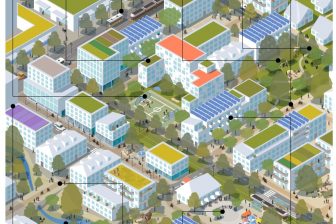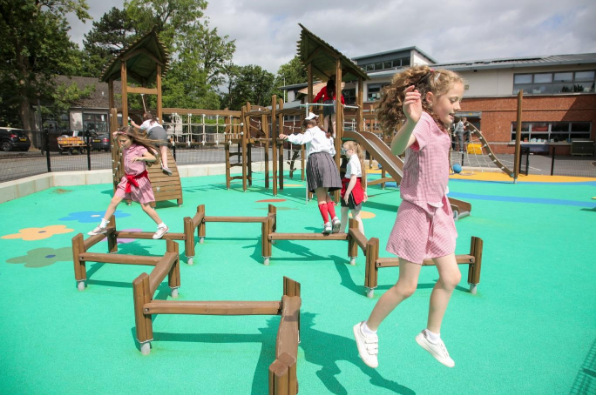
A child led approach to designing healthy and child friendly places
Belfast Healthy Cities has created a teaching resource to support a child led, creative approach to designing healthy and child friendly places. The teaching resource ‘Healthy Places, Healthy Children’ was created to educate children about the link between the built environment and their wellbeing.
It also helps children to develop their own proposals for improvement of the places they live and play in.
Context
Belfast, as a Healthy City, developed the concept of healthy urban environments during Phase III (1998-2002) of the WHO European Healthy Cities Network and initially, this work focused on sharing evidence and building capacity. Over time, however, the programme led to the identification of a gap in policy in relation to children, and child friendly places was identified as an opportunity to explore the practical application of the healthy urban environments concept.
A key driver for the child friendly places programme was the United Nations Convention on the Rights of the Child (UNCRC) (UNICEF, 1989), which establishes a right for children to both have access to a supportive environment and be heard in decisions that affect them (Articles 12 and 13). As such, a main aim of the programme was to provide children with a platform for sharing their views as a major but often less heard population group, whose healthy development and future engagement in society could be significantly strengthened through a greater sense of ownership, both in their communities and in decision making.
Rationale
To progress the child friendly places programme, Taking Action for Child Friendly Places, an inter-sectoral action plan based on extensive engagement with children across Belfast, was developed and was the first time such a focus has been put on children and the built environment in Belfast. About 7000 children and families were directly engaged with using innovative methods to identify priorities and the action plan set out partners’ responsibilities under the following areas: Engaging and Empowering Children; Creating Healthier Places and Supportive Environments; and, Tools for Child Centred Spatial Planning and Design.
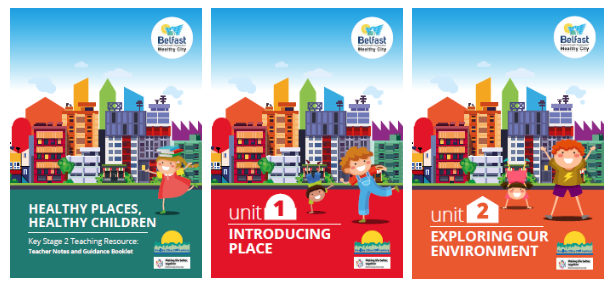
The first engagement model developed under the Plan was Shaping Healthier Neighbourhoods for Children, a project which engaged 400 children through schools to explore their experience of their local environment. The model included class-based sessions exploring healthy environments, a walk in the local neighbourhood, where children photographed what they liked and did not like, and a final imagining session to share ideas, prioritise and visualise an agreed proposal. The Photovoice method was used to encourage and enable children of all abilities to participate, and the process resulted in proposals highlighting children’s ideas of how their local neighbourhood could become more child friendly.
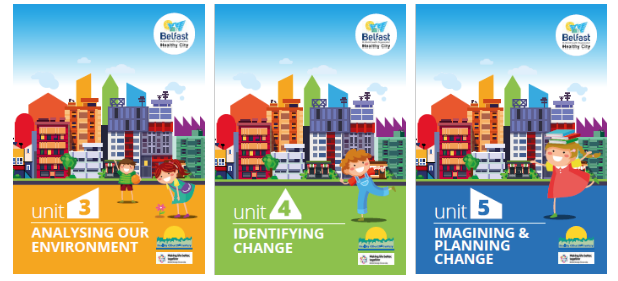
In 2015, in response to feedback from teachers, this model was developed into a dynamic teaching resource, in partnership again with the Education Authority, the Public Health Agency and Northern Ireland Housing Executive. This Healthy Places, Healthy Children resource has since been piloted with over 30 primary schools, both in Northern Ireland and across Europe, and has resulted in numerous proposals being developed by children. These pilots also encouraged children to present their proposals to decision makers, thereby supporting them to become active citizens and to take ownership of the places they live in.
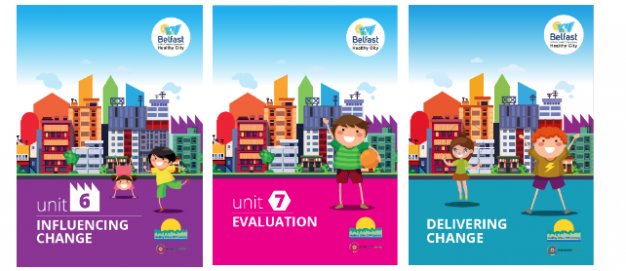
Description
Healthy Places, Healthy Children is a Key Stage 2 teaching resource that supports delivery of the Northern Ireland Curriculum on cross curricular skills such as critical thinking, teamwork and problem solving, as well as in relation to the World Around Us curriculum – a thematic area of learning comprising the subjects of geography, history and science and technology.
The resource, which can also be used in an afterschool’s or youth group setting, consists of seven Units, designed to support modular delivery over a flexible time period. The Units have been designed to introduce children to a project planning approach and enable children to work their way through a planning process from framing the issue and gathering evidence to identifying priorities and developing a delivery plan. The Units also include opportunities to explore different perspectives, compare subjective and objective assessments, and practise reaching consensus. Each Unit booklet sets out the learning intentions and contains teachers notes and learning exercises. The booklets are supported by a range of guidance and practical resources and a Delivering Change booklet – telling the stories of six schools who have successfully completed the programme is also available for peer learning.
Following the successful pilot, Belfast Healthy Cities, has recently launched an online version of the resource that allows the resource to be delivered on a regional and wider basis in the future. The online resource is available through www.belfasthealthycities.com/hphc and provides access to a range of training videos, all Unit booklets and supporting resources.
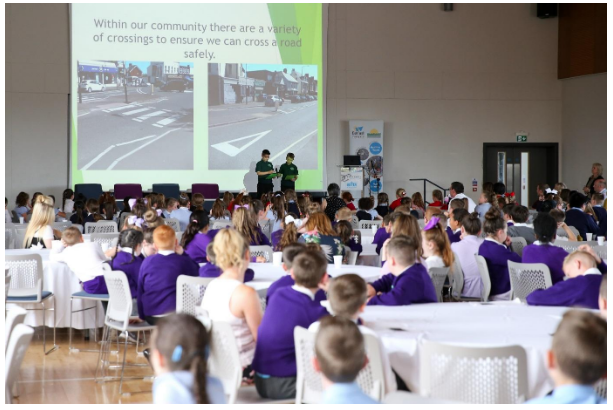
Achievements
The Healthy Places, Healthy Children resource has realised significant success as a tool for engaging children with decision makers to shape the built environment. It has demonstrated the capacity and interest of children to participate in the process, and has generated new data on how children aged 8-11 in Belfast view their local environment. Achievements to date have included:
- Wide ranging and significant projects developed and delivered in partnership within Primary Schools across Northern Ireland which have positively impacted on both the local environment and the mental and physical health and wellbeing of young people;
- Development of partnership working model that includes primary schools and local authorities, private business, members of the community, training providers etc;
- Successes in directly engaging children with decision makers, which is an important starting point for development of dialogue and longer term relationships;
- Giving child friendly places greater visibility with local authorities and in emerging policy though the development of links with the education sector and a number of statutory sector agencies. For example, the resource is supported by the Ministerial Advisory Group for Architecture and the Built Environment, which aims to work with private developers to create good quality built environments for all;
- The resource was a finalist in the category for Excellence in Planning for Health and Wellbeing at the prestigious Royal Town Planning Institute’s (RTPI) Awards for Planning Excellence in 2018.
Some examples of projects designed by children and delivered in partnership include: redesign of school playgrounds and construction of active and learning play equipment; installation of bins to reduce community littering; development of innovative outdoor learning facilities and spaces; allotment areas that engage the whole school in growing and cooking healthy food; introduction to joinery as a career path for an all girls school through furniture making classes to furnish their outdoor classroom; and improved public spaces.
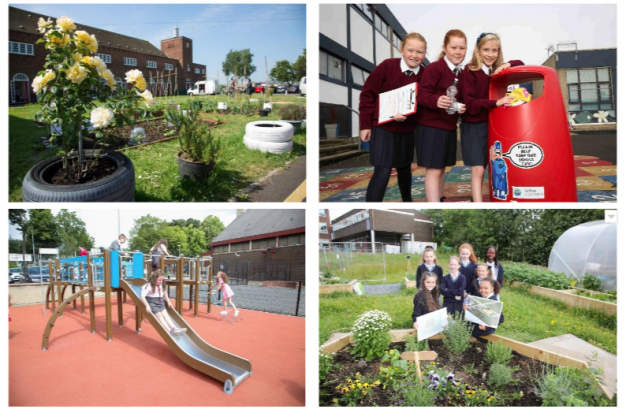
Conclusion
The Healthy Places, Healthy Children teaching resource was designed to enable children to explore the relationship between local built environments, their everyday lives and their health and to engage with and inform local decision makers. The resource uses teaching methods which embrace the principles of co-creation so children are empowered and have ownership of outcomes and also provides a platform for children to contribute towards decisions that affect them in places where they live, go to school and play. By adopting methods of co-creation the resource allows children to take ownership of outcomes and provides them with a platform to contribute towards decisions that affect them in places where they live, go to school and play. Such methods underpin Belfast Healthy Cities’ approach to promoting child friendly places, which aims not only to increase understanding of children’s needs among planners, but strengthen opportunities for children to directly influence decision making.
To access the resource guide click here.
Feature image photo credit: Belfast Healthy Cities




